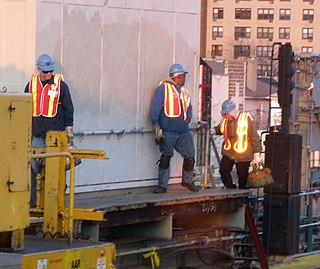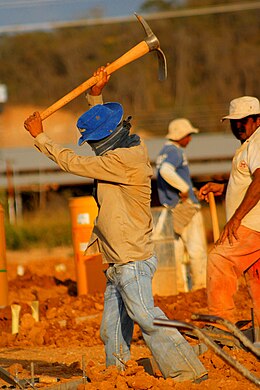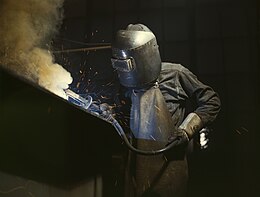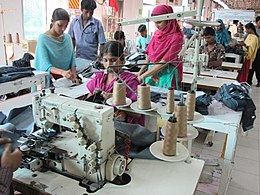
A sweatshop or sweat factory is a crowded workplace with very poor, illegal working conditions. The manual workers are poorly paid, work long hours, and experience poor working conditions. Some illegal working conditions include poor ventilation, little to no breaks, inadequate work space, insufficient lighting, or uncomfortably/dangerously high or low temperatures. The work may be difficult, tiresome, dangerous, climatically challenging, or underpaid. Workers in sweatshops may work long hours with unfair wages, regardless of laws mandating overtime pay or a minimum wage; child labor laws may also be violated. Women make up 85 to 90% of sweatshop workers and may be forced by employers to take birth control and routine pregnancy tests to avoid supporting maternity leave or providing health benefits. The Fair Labor Association's "2006 Annual Public Report" inspected factories for FLA compliance in 18 countries including Bangladesh, El Salvador, Colombia, Guatemala, Malaysia, Thailand, Tunisia, Turkey, China, India, Vietnam, Honduras, Indonesia, Brazil, Mexico, and the US. The U.S. Department of Labor's "2015 Findings on the Worst Forms of Child Labor" found that "18 countries did not meet the International Labour Organization's recommendation for an adequate number of inspectors."

A tradesperson or tradesman is a skilled worker that specialises in a particular trade. Tradespeople (tradesmen) usually gain their skills through work experience, on-the-job training, an apprenticeship programme or formal education.

A white-collar worker is a person who performs professional service, desk, managerial, or administrative work. White-collar work may be performed in an office or other administrative setting. White-collar workers include job paths related to government, consulting, academia, accountancy, business and executive management, customer support, design, economics, engineering, market research, finance, human resources, operations research, marketing, public relations, information technology, networking, law, healthcare, architecture, and research and development. In contrast: blue-collar workers perform manual labor or work in skilled trades; pink-collar workers work in care, health care, social work, or teaching; and grey-collar jobs combine manual labor and skilled trades with non-manual or managerial duties.

In macroeconomics, the labor force is the sum of those either working or looking for work :

A laborer is a skilled trade, a person who works in manual labor types, especially in the construction and factory industries. Laborers are in a working class of wage-earners in which their only possession of significant material value is their labor. Industries employing laborers include building things such as roads, road paving, buildings, bridges, tunnels, pipelines civil and industrial, and railway tracks. Laborers work with blasting tools, hand tools, power tools, air tools, and small heavy equipment, and act as assistants to other trades as well such as operators or cement masons. The 1st century BC engineer Vitruvius writes that a good crew of laborers is just as valuable as any other aspect of construction. Other than the addition of pneumatics, laborer practices have changed little. With the introduction of field technologies, the laborers have been quick to adapt to the use of this technology as being laborers' workforce.

A construction worker is a worker employed in the physical construction of the built environment and its infrastructure.
Embourgeoisement is the theory that posits the migration of individuals into the bourgeoisie as a result of their own efforts or collective action, such as that taken by unions in the United States and elsewhere in the 1930s to the 1960s that established middle class-status for factory workers and others that would not have been considered middle class by their employments. This process allowed increasing numbers of what might traditionally be classified as working-class people to assume the lifestyle and individualistic values of the so-called middle classes and hence reject commitment to collective social and economic goals. The opposite process is proletarianization. Sociologist John Goldthorpe disputed the embourgeoisement thesis in 1967.
A skilled worker is any worker who has special skill, training, knowledge which they can then apply to their work. A skilled worker may have learned their skills through work experience, on-the-job training, an apprenticeship program or formal education. These skills often lead to better outcomes economically. The definition of a skilled worker has seen change throughout the 20th century, largely due to the industrial impact of the Great Depression and World War II. Further changes in globalisation have seen this definition shift further in Western countries, with many jobs moving from manufacturing based sectors to more advanced technical and service based roles. Examples of formal educated skilled labor include engineers, scientists, doctors and teachers, while examples of informal educated workers include crane operators, CDL truck drivers, machinists, drafters, plumbers, craftsmen, cooks and bookkeepers.

A pink-collar worker is someone working in the care-oriented career field or in fields historically considered to be women's work. This may include jobs in the beauty industry, nursing, social work, teaching, secretarial work, upholstery, or child care. While these jobs may also be filled by men, they have historically been female-dominated and may pay significantly less than white-collar or blue-collar jobs.
In the postwar decades, the standard of living in Japan has undergone a dramatic rise. Some observed changed has been a reduction of the gap between blue and white collar workers. What was once considered the "three sacred treasures", was possessed by 90% of households by 1964. By the 1970's, the living conditions of the working class were considered to be as high as those in the West. Japanese consumers have benefited from the nation's economic growth, while in turn they have stimulated the economy through demand for sophisticated products, loyalty to domestically produced goods, and saving and pooling investment funds. But personal disposable income has not risen as fast as the economy as a whole in many years—at 1 percentage point less than average GNP growth in the late 1980s.

The modern social structure of France is complex, but generally similar to that of other European countries. Traditional social classes still have some presence, with a large bourgeoisie and especially petite bourgeoisie, and an unusually large proportion, for modern Europe, of farming smallholders. All these groups, and the remaining industrial working class, have considerable political power, which they are able to flex when required.
Grey-collar refers to the balance of employed people not classified as white- or blue collar. It is occasionally used to describe elderly individuals working beyond the age of retirement, as well as those occupations that incorporate some of the elements of both blue- and white-collar, and generally are in between the two categories in terms of income-earning capability.

Workwear is clothing worn for work, especially work that involves manual labour. Often those employed within trade industries elect to be outfitted in workwear because it is built to provide durability and safety.

A green-collar worker is a worker who is employed in an environmental sector of the economy. Environmental green-collar workers satisfy the demand for green development. Generally, they implement environmentally conscious design, policy, and technology to improve conservation and sustainability. Formal environmental regulations as well as informal social expectations are pushing many firms to seek professionals with expertise with environmental, energy efficiency, and clean renewable energy issues. They often seek to make their output more sustainable, and thus more favorable to public opinion, governmental regulation, and the Earth's ecology.
Blue collar workersin Japan encompass many different types of manual labor jobs, including factory work, construction, and agriculture. Blue-collar workers make up a very large portion of the labor force in Japan, with 30.1% of employed people ages 15 and over working as "craftsman, mining, manufacturing and construction workers and laborers" as of 1995 census data. The blue-collar class includes regular, non-regular, and part-time workers, as well as a large number of foreign laborers, all with varying work schedules and employment benefits.
Economic restructuring is used to indicate changes in the constituent parts of an economy in a very general sense. In the western world, it is usually used to refer to the phenomenon of urban areas shifting from a manufacturing to a service sector economic base. It has profound implications for productive capacities and competitiveness of cities and regions. This transformation has affected demographics including income distribution, employment, and social hierarchy; institutional arrangements including the growth of the corporate complex, specialized producer services, capital mobility, informal economy, nonstandard work, and public outlays; as well as geographic spacing including the rise of world cities, spatial mismatch, and metropolitan growth differentials.
Collar color is a set of terms denoting groups of working individuals based on the colors of their collars worn at work. These can commonly reflect one's occupation within a broad class, or sometimes gender; at least in the late 20th and 21st century, these are generally metaphorical and not a description of typical present apparel. For the two terms of longest use, white-collar workers are named for the white-collared shirts that were fashionable among office workers in the early and mid-20th century. Blue-collar workers are referred to as such because in the early 20th century, they usually wore sturdy, inexpensive clothing that did not show dirt easily, such as blue denim or cambric shirts.

The working class or in Marxist terms, The Proletariat, includes all employees who are compensated with wage or salary-based contracts. Working-class occupations include blue-collar jobs, and most pink-collar jobs. Members of the working class rely exclusively upon earnings from wage labour; thus, according to more inclusive definitions, the category can include almost all of the working population of industrialized economies, as well as those employed in the urban areas of non-industrialized economies or in the rural workforce.

Work or labour is the intentional activity people perform to support the needs and wants of themselves, others, or a wider community. In the context of economics, work can be viewed as the human activity that contributes towards the goods and services within an economy.
Dagongmei are Chinese female migrant workers in the cities. This term emerged during the post-Mao Reform Period (1978-) and is still a relevant term in the present day. Its purpose was to denote a new kind of labor relation that distinguishes itself from the labor relations during the Mao Era.
















